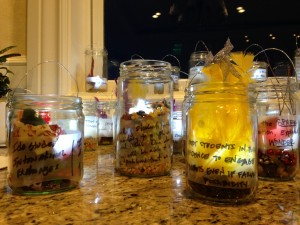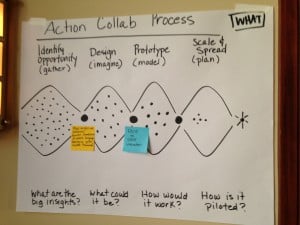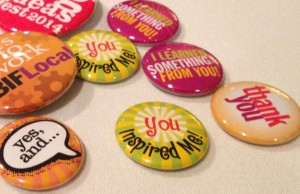Big Ideas Fest is a unique conference. When I first saw tweets about it, even the name intrigued me. Who wouldn’t want to talk about the big ideas?
More workshop than conference, actually, it allows attendees to become artists, idea builders, and potentially, innovators. The conference provides a mixed format to spur innovation and team building — from speakers to an artist in residence to improv — all combining to help further the agenda, which is learning to use Design Thinking to address “big ideas” in education.
 From arriving the first night when we created luminarias of our hopes for education with the conference’s artist in residence, to spending two days working on design challenges, to closing with a hula-hooping keynote, the conference tapped into the potential of community.
From arriving the first night when we created luminarias of our hopes for education with the conference’s artist in residence, to spending two days working on design challenges, to closing with a hula-hooping keynote, the conference tapped into the potential of community.
Big Ideas Fest takes place in the beautiful Half Moon Bay Ritz Carlton which is set away from the town itself. Perhaps that aids in community building since many attendees stay there the entire three days. There are fireside chats, keynotes, Rapid Fire talks, walks at sunset, Fit Bit challenges, and things like hula hooping practice interwoven into the schedule.
Solving the big problems
In past years, Big Ideas Fest has used design thinking to surface and address big problems in education and focused on solving one. This year, participants’ own design challenge questions became central to the workshop. For example, our team worked on three challenges (one of them mine) to come up with designed solutions to address problems we faced.
Improv was a central part of the conference–we used it to meet our neighbors, warm up, connect after breaks, etc. and it did add to the camaraderie of the event. Facilitator Megan Simmons shared tenets of improv with our team:
- let go of your agenda
- listen in order to receive
- build on what you receive
- can’t be wrong
- make your partner look brilliant
- keep moving forward
“Make Your Partner Look Brilliant”
I have carried these tenets beyond the conference, really reflecting upon what it means to “make your partner look brilliant” and that in brainstorming you “can’t be wrong.” It was very liberating as we worked in our particular team when anyone faltered, to hear the whole group cheer – “You can’t be wrong.”
We also spent time talking about “Yes, And” strategies, which Carl Hooker first shared with me (I believe via an Apple workshop.) The idea is to extend upon an idea. Rather than responding to a challenging concept by saying all the “buts” and reasons it won’t work, the idea is to “extend” or build upon the other persons idea with a “Yes, and, what if…” sort of statement. In any communication situation, this strategy can help open up dialogue rather than shutting it down, and is a beneficial practice for everyone from administrators to library managers to teachers. And in this blogging, tweeting world, the notion of “making your partner look brilliant” really stuck with me for further reflection.
Part of what makes Big Ideas work is this sense of community the conference tries to foster. Another aspect of the conference I loved was “buttonology”. When we arrived at the conference, each participant got a zippered pencil bag filled with buttons. When we felt appreciation for someone else or wanted to thank them, we were tasked with sharing our buttons with them. It felt really gratifying to share a “button” with a Road Trip Nation student I met, or with a shyer member of the community to thank them for their ideas, and it just created a huge sense of generosity that I think any conference would want to support.
Design Thinking process
For the bulk of the conference, participants joined teams which addressed a couple of design challenges, and learned how to move through the “action collab” or design thinking model that ISKME uses in which you:
 Identify opportunity (gather info)
Identify opportunity (gather info)
Design(imagine) – What could it be?
Prototype (model) How would it work?
Scale and Spread (plan) How is it realized?
We interviewed clients, brainstormed in teams, did improv, narrowed questions and solutions to ultimately address the design challenge we were working on. On Day Two, we worked on our own design challenge questions in teams, and for me, a real project emerged from our solutions which I will be blogging about in another post.
One of the initial parts of the design challenge I found interesting was interviewing the “client.” We were asked to listen and simply list observations of what was said. Observations–no judgments, no inferences, but simply — “The client said….x.” It forced some deeper listening and also led to better brainstorming after the fact.
The team building was also key to this process working because collaboratively was essential to having a team open to brainstorming.
My Takeaways
- Crafting an experience like this means attention to detail, feeling, and vision.
- Professional development that builds a spirit of generosity creates an environment more conducive to openness.
- Buttonology is cool.
- Having an “artist in residence” for a conference is also cool.
- Improv opens up a lot of energy in participants and is refreshing on a long PD/conference day.
- We should “make our partners feel brilliant.”
- The design thinking/action collab process is a very effective way to move teams through brainstorming solutions.
When we empower teams with strategies for approaching problems, we can draw upon the best of their collective wisdom, something education in general needs to do more of. When we empower students to do the same, who knows what they can discover or create.
In a future blog post, I’ll share what our team came up with in response to my design question….
